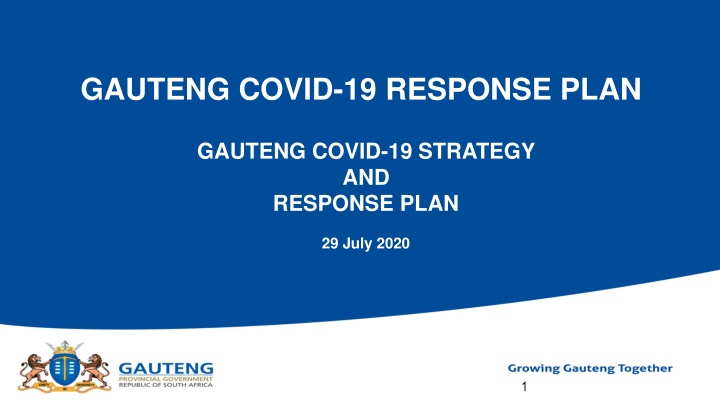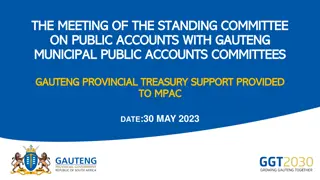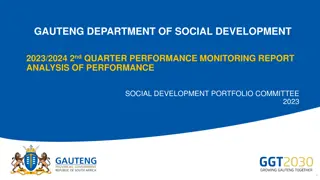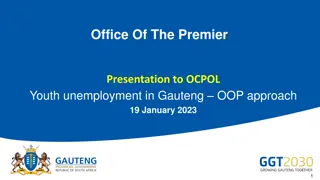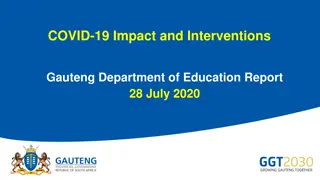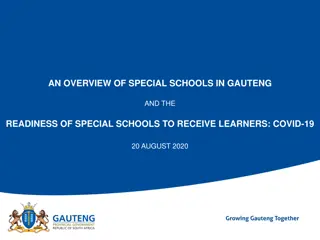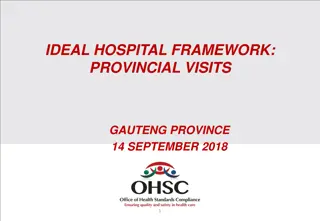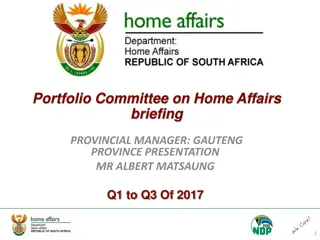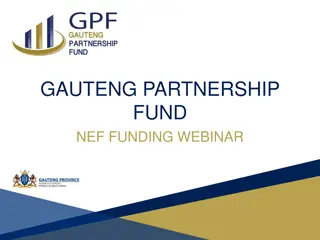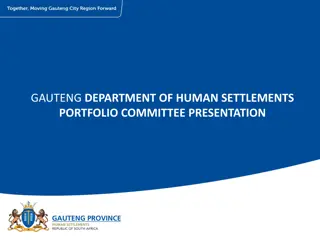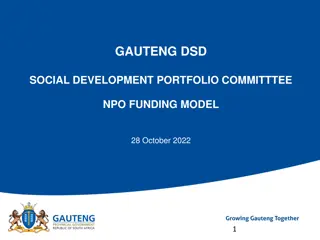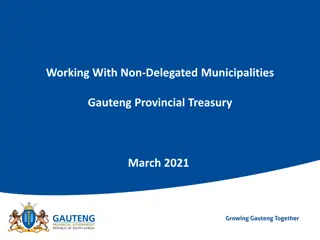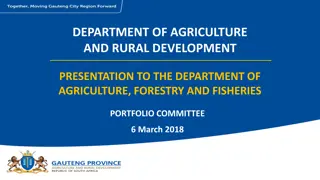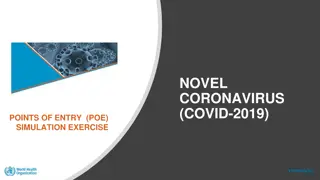Gauteng COVID-19 Response Strategy Overview
Gauteng's comprehensive response plan to the COVID-19 pandemic includes a six-pillar strategy focusing on surveillance, contact tracing, healthcare system readiness, designated treatment hospitals, and social mobilization efforts. The Gauteng Department of Health is leading extensive measures encompassing health response, social relief, case management, contact tracing, community mobilization, and more to combat the spread of COVID-19 effectively.
Download Presentation

Please find below an Image/Link to download the presentation.
The content on the website is provided AS IS for your information and personal use only. It may not be sold, licensed, or shared on other websites without obtaining consent from the author.If you encounter any issues during the download, it is possible that the publisher has removed the file from their server.
You are allowed to download the files provided on this website for personal or commercial use, subject to the condition that they are used lawfully. All files are the property of their respective owners.
The content on the website is provided AS IS for your information and personal use only. It may not be sold, licensed, or shared on other websites without obtaining consent from the author.
E N D
Presentation Transcript
GAUTENG COVID-19 RESPONSE PLAN GAUTENG COVID-19 STRATEGY AND RESPONSE PLAN 29 July 2020 1
CONTENT BACKGROUND GAUTENG COVID-19 SIX PILLAR STRATEGY GAUTENG S COMPREHENSIVE HEALTH RESPONSE GAUTENG COVID-19 SUMMARY UPDATE 21 JULY OPERATING MODEL PLANNING PHASES SCENARIO MODELLING HEALTH RESOURCING PLAN, JULY SEPTEMBER AT PEAK PROGRESS REPORT ADDITIONAL HOSPITAL BEDS UNDER CONSTRUCTION FINANCIAL RESOURCE REQUIREMENT CONCLUSION
Background: Gauteng COVID-19 Six pillar strategy Gauteng s measures to deal with COVID-19 prior to the declaration of the state of national disaster included: In response to the Covid-19 Pandemic Gauteng adopted a six-pillar strategy Establishment of a multi-sectoral coordination teams at both Provincial and District levels for the COVID-19 response, to ensure sufficient preparatory work gets underway Strengthening capacity to undertake surveillance for COVID-19 at Provincial and District levels Training of teams of contact tracers to ensure that positive case contacts can be expeditiously located, tested and quarantined Ensuring that the Province s health-care system is prepared to receive, manage and report on the clinical progress of persons with COVID-19 The designation of three hospitals Charlotte Maxeke Academic Hospital, the Steve Biko Academic Hospital as well as Tembisa Tertiary Hospital, for appropriate treatment of confirmed cases Comprehensive Health Response Law Food Security and Social Relief enforcement and compliance Gauteng COVID-19 Response Social mobilisation and Human Solidarity State Capacity and Adaptability Economic Response
GAUTENGS COMPREHENSIVE HEALTH RESPONSE The following constitutes the Gauteng Department of Health (GDOH) response to the Covid-19 pandemic: Comprehen sive Health Response Food Security and Social Relief Effective Case Finding and Management of Cases, Effective Contact Tracing and Management of Contacts, Community Mobilization, education and advocacy, Law enforceme nt and compliance Hospitalization of Covid-19 patients, providing Ventilated Beds, High Care/Critical Care Beds and General Beds, Management of Quarantine and Isolation Sites, Management of non-COVID Health Programs Gauteng COVID-19 Response Social mobilisat ion and Human Solidarity State Effective Management of the School Health Program in the context of Covid-19 pandemic, Transportation/Transfer of Covid-19 cases, Effective Management of Forensic Services Capacity and Adaptability Economic Response Effective management of Occupational Health GDOH is also required to manage and operate critical and essential health programs during this period.
GAUTENG COVID-19 STRUCTURES Provincial Coronavirus Command Council District Command Councils Metro & District Mayors Provincial Disaster Management Command Centre (PDMCC) Provincial Director General & Provincial Police Commander Provincial Joints Provincial Police Commissioner
MANDATE OF PROVINCIAL CORONAVIRUS COMMAND COUNCIL Core members and participatory members Chair: Premier Delegation of decisions Key activities Cadence Provide directives in line with National Coronavirus Command Council Enforce accountability against performance measures Determine the appropriate policies for the Gauteng City Region Provide strategic guidance to the district council and the PDMCC Resolve escalated issues that could not be resolved at lower levels Unlock national resources for provincial and local levels Twice a Week Provide directives Set targets to be achieved Consider proposals for medium-term to long-term measures for approval by EXCO Provincial Coronavirus Command Council Provincial MECs Provincial Director General Police commissioner
MANDATE OF DISTRICT CORONAVIRUS COMMAND COUNCIL Core members and participatory members Chair: District Mayors District PMOs Mayoral Committees Delegation of decisions Key activities Cadence Implement Strategic directives from the PCCC to the municipalities Escalating district challenges to the PCC Analyse performance of districts Unlock resources in response to Covid-19 Ensure alignment to provincial response measures Guide local gov structures to enable effective delivery Promote co-operation amongst local government and external interfaces Enforce controls within the District Weekly Clarify the operational implications of directives, policies and decisions from the PCCC Make approvals on resources to be allocated for delivery Escalate issues to the PCCC District Coronavirus Command Council
MANDATE OF PROVINCIAL DISASTER MANAGEMENT COMMAND CENTRE (PDMCC) Core members and participatory members Key activities Cadence Delegation of decisions Monitor and Assess performance level of the PDMCC Mitigate workstream risks Resolve escalated issues, otherwise escalate to PCCC Assess performance measures of workstreams Challenge approach delivery to address impending risks and issues Promote co-operation amongst work-streams and external interfaces Daily Approve request for further resource mobilisatio n Changes to scheduling of resources Issuing consequences for non-performance PDMCC Co Chaired: MEC for Health & Provincial DG PMO Work-stream leads/ HODs Prov Joint Reps Provincial Reps from National Entities and agencies
OPERATING MODEL COVID 19 PROJECT - WORKSTREAMS SCOPE Sub-Workstreams Comprehensive Health response Work stream interface Case Health Ports of Entry and Health Travel Laboratory Services Emergency Medical Response Epi & Surveillance Research Management Infrastructure Housing for Vulnerable Groups Sports and Recreational Activities Education Continuity Donor Management Social Security response Work stream interface Food Security Strategic Sites, Public Facilities and Areas Industries (Industrial Business) Enforcement and Compliance Business & Commerce Hotspots & Vulnerable Areas Transportation Work stream interface Manufacturing & Green Economy Economic Response SMME Economic Response Transportation and Logistics Trade, Travel & Tourism Financial & Business Services Agriculture Construction Work stream interface Adoption of IDP and Budget (ICT Support infrastructure) Budget Reprioritization (Revenue Loss) De- De-congestion of Informal Settlements and Services to Hostels Business continuity Plans Coordination & Analysis Local Government contamination/ Sanitization & Waste Management Local Economic Development Response Burial Capacity (Cemeteries) and Crematoria) Water Provision and Sanitation Work stream interface Government Continuity Work stream interface Service Delivery Redesign Workforce Strategies Change Management Continuity and OHS Planning
LESSONS LEARNT IN FIRST 30 DAYS CASE FOR CHANGE There are three key factors that are driving the case for change that contextualise the learnings since commencement of response operations, the requirements for the anticipated peak of cases and the longer-term needs of the response 1 Learning from the first 30 days The first 30 days has given us a good understanding of how our response has been successful such as decisive leadership and inter- governmental collaboration. Experiential learning It has also highlighted what is required to strengthen the response in terms of strategic alignment and improve management capacity. These learning are derived from the collective experiences of the teams involved the feedback from stakeholders thus far. It is important to build on what has started to create a more sustained response both during the peak and the recovery. 2 Planning for the anticipated peak All current indications are that we are expecting a peak in the pandemic during the winter season and it will be important to scale up and solidify the response measures in place to ensure a more robust response( Ward/Suburb/Focus) during this period (June, July, August & September). (Dashboard partnership with IBM, WITS, UP & GCRO Preparing for the worst Simultaneously there will be a relaxing of the lock-down to allow for some increased economic activity. This will require a clear focus on the most critical elements with interfaces to various stakeholders to support joint efforts (Ward Based Teams). 3 The management of this must support direct delivery to the frontlines while planning for the medium term. Sustainability of the response for a 6 12 months period There is a realisation that the pandemic will be long-lived with major structural changes anticipated post the pandemic to strengthen key structures that will sustain the long-term measures required to survive the pandemic and the recovery phase. Building for continuity It will also be important for this to evolve structurally as scenario changes and there is a need to enable government continuity through a dedicated response capacity.
PLANNING PHASES - ALIGN EFFORTS OVER THE MAJOR UNFOLDING EVENTS Q1 20 Q2 20 Q3 20 Q4 20 Q1 21 Q2 21 Q3 21 Q4 21 Healthcare Crisis Phase 1: Before the Peak *Food Riot This phase focuses on actively preparing the required capacity to manage the peak. This also includes scaling up capacity for service delivery during the peak for all essential services to minimise any further impact. *Unemployment crisis Phase 2: During the Peak *Eviction crisis Phase 3: Post the Peak This phase focuses strictly on managing the pressure on the service delivery. This will also include re-introducing lock-down measures and enforcing strict compliance (suburban and ward level) This phase focuses restoring services and clearing backlog demand that could not be fulfilled. It will be critical to assess collateral damage and put in place measures for a potential 2ndwave Economic Crisis Phase 1: Respond Phase Phase 2: Recover Phase This phase focuses on minimise the impact of the crisis by providing a cushion to both businesses and employees. These may include payment holidays, employee benefits etc.. This phase focuses on activities that will support the restarting of economic sectors that are poised to grow whilst managing those sectors that will require Fundamental change(e.g. airline industry) Phase 3: Thrive Phase This phase focuses on activities that will drive growth of the economy to become competitive both in the local and regional market. Activities here may include enhancing regional trade corridors Government Response the business of government Essential and Permitted Services Essential and Permitted Services scaled up at 30% - 50% 70% of services operating in a new delivery model 11
SCENARIO MODELLING Estimating the expected # of cases South African (NDoH) COVID- 19 modelling consortium Gauteng model (based on GP data) 419 654 -541 137 Active symptomatic cases 313 000 400,000 ICU beds in use at peak 8 000 - 11 000 7 973 - 10 281 Non-ICU beds in use at peak 25 000 30 000 54 873 -70 888 Peak period Parametric assumptions Mid August - early Sept 2020 Early Sept 2020 Mild cases 95% of active cases 85% of active cases Critical cases (ICU/High care bed) 1.16% to 1.45% 4.8% Severe cases (general ward bed) 2.46% to 3.64% 10.2% 4
SCENARIO MODELLINGHEALTH RESOURCE REQUIREMENTS Guided by the national framework on health resource requirements, Gauteng applied the following to estimate the bed requirements Used the NDOH model for estimating long-term hospital bed requirements Gauteng reviewed the long-term hospital bed predictions provided by the South African COVID-19 Modelling Consortium, which provided predictions for the critical care beds and more optimistic prediction for general ward bed requirements. This model predicted a minimum of 8000 critical beds for the peak. Used the Gauteng model for estimating short-term (30 June) and medium-term (31 July) hospital bed requirements Gauteng adopted the predictions provided by a team of experts appointed to provide modelling of the progression COVID- 19 infections. This modelling applied several assumptions on the spread of infections, and then this was used to model / predict the number of hospital beds (for ICU/high care, general ward beds and ventilated cases) that will be required as well as the additional resources that would be needed to ensure that the health system is ready for the anticipated peak. Both models predicted approximately the number of cases. This information is what the Gauteng Provincial Government has used to create targets and plans for the required resources. 3
HEALTH RESOURCING PLAN, JULY SEPTEMBER AT PEAK CASES MEDICAL TECH HOSPITALISATION INFRASTRUCTURE CASES AND HOSPITALISATION GAP ON REQUIRED GAP ON PLANNED REQUIRED CURRENT PLANNED GAP ON REQUIRED REQUIRED CURRENT PLANNED (at peak) General Beds Ventilator Numbers Ventilator Numbers Ventilator Numbers Ventilator Numbers Ventilator Numbers High Care ICU General Bed High Care ICU General Bed High Care ICU General Bed High Care ICU General Bed High Care ICU 25 000 8 000 4 000 7500 2400 2236 744 166 2005 166 2005 1203 101 1102 1102 1102 HUMAN RESOURCES OXYGEN OTHER KEY SUPPLIES GAP ON REQUIRED GAP ON PLANNED REQUIRED GAP ON REQUIRED GAP ON PLANNED REQUIRED PLANNED GAP ON REQUIRED REQUIRED CURRENT PLANNED CURRENT PLANNED Gap on planned ventilators Gap on planned ventilators Required ventilators Current ventilators Planned ventilators Gap on planned Required ventilators Current ventilators Planned ventilators Gap on planned Nurses Doctors Other Nurses Doctors Other Nurses Doctors Other 3 802 1091 2 936 2 851 782 2 073 262 256 2671203 101 1102 1102 1102 2 636 - 2 636 2 636 2 636 Details of other supplies: OTHER CRITICAL REQUIREMENTS Infusion Pumps Syringe Pumps Suction - Electric Suction units-Wall mount Oxygen Flow meters NUMBER 880 880 16 430 430 2636
PROGRESS REPORT ADDITIONAL HOSPITAL BEDS UNDER CONSTRUCTION Project Status 75% DISTRICT Project Name Total No. of Beds Johannesburg Lenasia South CHC 103 Charlotte Maxeke J Academic Hospital Chris Hani Baragwanath Hellen Joseph Discoverers CHC Anglo Ashanti (Westonaria) 55 604 10 70 175 616 40 300 100% 23% 95% 60% 65% 46% 92% 5% West Rand Tshwane Dr Given Mukhari Academic Hospital Tshwane District Hospital Jubilee Hospital (Hamanskraal) Kopanong Hospital Tembisa Hospital Sedibeng Ekurhuleni 345 100 100% 87% 68% Totals 2 418
FIELD HOSPITAL PLANNING FOR ADDITIONAL GENERAL BEDS Despite the planned infrastructure development, it is calculated that Gauteng may still have a General bed Short fall before the peak. Seven (7) areas have been identified for the rollout of the field hospitals for additional general beds to meet the short fall Area (Site) identified Required General Beds Progress Phase: 500 Beds completed. Phase 2: 1000. 285 completed. 249 completed by 24th July and 366 by the 9th of August 1500 NASREC 500 500 300 720 1500 284 Diepsloot Soshanguve Midrand/Chloorkop Daveyton Tshwane Show Ground Rand Clinic 5020 Total
PROGRESS ON ALTERNATIVE BUILDING District Hospital Programme Capacity Progress Tshwane Jubilee ABT- 300 5% DGMAH ABT 300 20% Johannesburg CHBAH ABT 500 10% Sedibeng Kopanong ABT 300 10% Total 1400
PROGRESS ON FEVER AND TRIAGE AREAS DISTRICT HOSPITAL PROGRAMME NUMBER OF BEDS PROGRESS END Sedibeng Sebokeng Fever Tent 50 100% Kopanong Fever Tent 50 100% Hieldburg Fever tent 50 100% Total 150 Johannesburg Bheki Mlangeni Fever Tent 50 90% Endevale Fever Tent 100 Helen Joseph Fever Tent 50 90% Rahimah Moosa Hall 80 Total 280 Ekurhuleni FERH Fever Tent 50 100% Pholosong Fever Tent 50 100% Tambo Memorial Fever Tent 100 100% Thelle Mogoerane Fever Tent 50 100% Total 1010
PROGRESS ON FEVER AND TRIAGE AREAS District Tshwane Hospital DGMAH Programme Fever Tent Bed capacity 50 Progress Mamelodi Kalafong Fever Tent Fever Tent 65 50 operational Jubilee Fever Tent 50 SBAH Fever Tent 15 operational Total 230 West Rand Leratong Fever Tent 50 Yusuf Dadoo Fever Tent 50 Carlonville Fever Tent 50 150 Grand Total 380
FINANCIAL RESOURCE REQUIREMENT Area Needs Requirement Available Resources Funding Gap (ADDITIONAL) R 0,401 billion Operational Costs (PPE, Oxygen, Testing etc.) R 2,165 billion R 1,764 billion Equipment (Health Technology) Infrastructure/Facilities & Current ABT Field Hospitals R 0,550 billion R 0,090 billion R 0,460 billion R 1,881 billion R 1,217 billion R 0,664 billion R 1,481 billion R 0, 500 billion (NASREC) R 0,510 billion R 0,981 billion Quarantine/Isolation R 6,900 billion R 6,300 billion HR Costs R 1,560 billion R 0,670 billion R 0,890 billion TOTAL R 14,537 billion R 4,700 billion R 9,700 billion
CONCLUSION The gap analysis shows therefore we require national government to support; This is because the available critical care and general ward beds are not sufficient to meet the predicted demand for Covid-19 hospitalisation in the medium-term (31 July) and at the peak (early September). Based on the prioritization process, the following areas have been prioritized immediate funding: Field Hospitals Infrastructure/Facilities & Current ABT Operational Costs (PPE, Oxygen, Testing etc.) In order for Gauteng to reach its plans, it has quantified that it will require an additional funding R 9,700 billion, we have received support from the Solidarity Fund at the tune of R 200 Million? The investment will go a long way in building a sustainable public health system in Gauteng 5
THANK YOU 24
